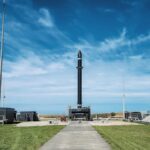Even though we can explore the universe with great precision, there is still a lot we don’t know, according to Ulf Danielsson, professor of theoretical physics at Uppsala University. Besides
phys.org13- Page
When it comes to finding baby, still-forming planets around young stars, the Atacama Large Millimeter/submillimeter Array (ALMA) observatory is astronomers’ most adept tool. ALMA has delivered many images of the
At the heart of the Milky Way, just 27,000 light-years from Earth, there is a supermassive black hole with a mass of more than 4 million suns. Nearly all galaxies
What began with tragedy ended in triumph. This is the untold story of the European Space Agency’s pioneering 25-year Cluster mission to study how invisible solar storms impact Earth’s environment.
An international team of scientists, led by the University of Oxford, has achieved a world-first by creating plasma “fireballs” using the Super Proton Synchrotron accelerator at CERN, Geneva, to study
For the first time, an international research team led by the Shanghai Astronomical Observatory (SHAO) of the Chinese Academy of Sciences has demonstrated that applying pixelized strong-lensing modeling on a
India launched its heaviest ever communication satellite on Sunday, the latest step in the country’s ambitious space program.
The moon will look slightly bigger and brighter Wednesday night during the closest supermoon of the year.
China announced Saturday that its Shenzhou 21 spaceship docked with China’s space station with its latest three rotation crew at the country’s own record speed after a successful launch.
NASA hit back on Thursday at reality TV star Kim Kardashian’s claim that the 1969 moon landing “didn’t happen,” a theory consistently debunked over decades.
-
 012024 in Review: Highlights from NASA in Silicon Valley
012024 in Review: Highlights from NASA in Silicon Valley -
 02Panasonic Leica Summilux DG 15mm f/1.7 ASPH review
02Panasonic Leica Summilux DG 15mm f/1.7 ASPH review -
 03From Polymerization-Enabled Folding and Assembly to Chemical Evolution: Key Processes for Emergence of Functional Polymers in the Origin of Life
03From Polymerization-Enabled Folding and Assembly to Chemical Evolution: Key Processes for Emergence of Functional Polymers in the Origin of Life -
 04How New NASA, India Earth Satellite NISAR Will See Earth
04How New NASA, India Earth Satellite NISAR Will See Earth -
 05And Thus Begins A New Year For Life On Earth
05And Thus Begins A New Year For Life On Earth -
 06Astronomy Activation Ambassadors: A New Era
06Astronomy Activation Ambassadors: A New Era -
07SpaceX launch surge helps set new global launch record in 2024





